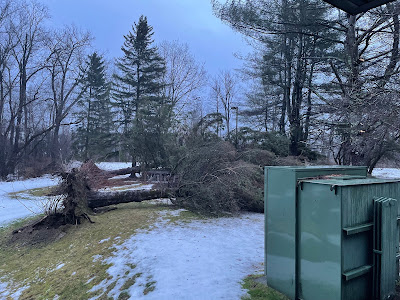 |
| I'm joking, of course, but it's so warm in Vermont that I wonder if I will be tending flowers like these when I get back to the Green Mountain State in a few days. |
The current warm spell way over-performed yesterday and overnight in Vermont and in all of the Northeast as incredible spell of spring time weather enveloped the region.
Record highs fell in dozens of cities from Ohio and Michigan to the East Coast and on up through New England and southeastern Canada. Vermont certainly shared in these balmy readings.
The Vermont record highs included readings of 58 degrees in both Burlington and Montpelier, easily exceeding the previous records set in 1990. Plattsburgh and Massena, New York also set record high temperatures. Low temperatures in Vermont Friday also set records for highest minimum temperatures for the date.
In other spots in this vast heat zone on Friday, some records fell by remarkable margins. Pellston, in northern Michigan, reached 55 degrees, besting the old record of 42 degrees.
The National Weather Service office in Gaylord, Michigan posted two photos to Twitter, one showing the 25 inches of snow on the ground a week ago, and another showing large patches of bare ground Friday from the huge thaw.
Ottawa, Canada had its second day in a row with record high temperatures Friday when it reached 48 degrees. The record high there Thursday was 44 degrees.
On Thursday, record highs were set as far west as Iowa and Missouri.
Back here in Vermont, last night turned out to be off the charts balmy. In Burlington, the "low" temperature in Burlington was 52 degrees, which is about normal for the opening days of June, not the end of December.
The record high for today is 56 degrees. I'm not sure we'll make it, as rain moving in will blunt high temperatures. Still, by 10 a.m., it will have been continuously at least 50 degrees in Burlington for a full 24 hours, which is a very rare feat for the dead of winter.
Even more remarkably, Montpelier reached 61 degrees early this morning as southwest winds pushed balmy air into the state capitol. Lighter winds later allowed temperatures in Montpelier to drop to 45 degrees. But my gawd! 61 degrees in Montpelier at 2 a.m. is perfectly normal - for the middle of July.
That 61 degrees is obviously a record high for the date in Montpelier, besting 56 degrees set in 1965.
It was so warm Friday that maple sugar production - a March and April tradition in Vermont - got going. Web cam at Branon Family Maple Orchards in Fairfield showed sap flowing into one of their tanks. I'm sure other sugar makers in Vermont are taking advantage of this rare winter heat to get a serious, serious jump on the season.
I'm assured by my friend Matt Crawford, who knows a thing or two about sugaring, that this early sugaring won't harm the trees and will have little if any effect on the "real" sugaring season in March.
Crawford also points out that the fact that people are sugaring in Vermont on New Year's Eve is not a weird sign of climate change. People just didn't have the wherewithal to tap and collect maple sap off season a generation or two ago. New technology and knowledge makes this possible today.
However, the fact that it's been so warm, and we've had so many of these weird December/winter heat waves in recent years could well be a sign of climate change.
Some recent examples: It was 70 degrees in Rutland on Christmas Eve, 2015, and Burlington reached 68 degrees that day, its hottest December temperature on record.
And on Christmas Day, 2020, it was 65 degrees in Burlington for a record high.
LOOKING AHEAD
The heat wave in Vermont might have peaked for now, but it's going to stay mild for quite awhile yet. Light rain, drizzle, fog and low clouds will rule tonight, so midnight fireworks displays still look tricky in spots.
Temperatures will fall on New Year's Day, but still remain above normal. They'll go from the 40s to the 30s.
Another surge of very toasty air looks to arrive Tuesday and Wednesday with the next storm. I see potential for more record-threatening temperatures on those days.
After that, it looks like we'll have a more extensive cool down, but temperatures will probably remain near or a little above normal for January.
For those of you who love winter, there are some signs we could go toward a colder, snowier pattern in the second half of the month. Before you get too excited, those are some pretty uncertain signs, and there's no guarantee.
Still, it's way, way too soon to write this season off as the year without a winter.


















